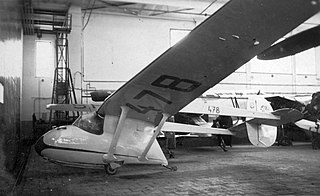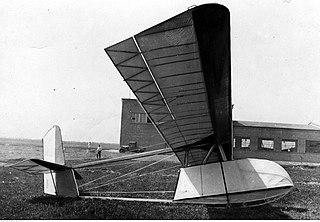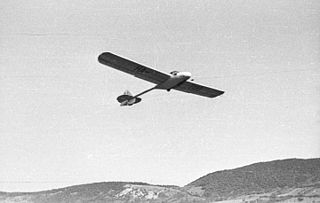The Czerwiński Sparrow, sometimes known as the de Havilland Canada glider, was a single seat glider, designed and built by a group of de Haviiland engineers in Canada in 1942. It was intended to popularise gliding and be suitable for both basic training and thermal soaring.
The Teichfuss Astore was an Italian Intermediate single-seat trainer glider designed by Luigi Teichfuss and flown in 1936. Two were built.
The RRG Professor was a very early soaring glider and the first to use a variometer for finding thermals. It was designed by Alexander Lippisch in Germany, first flying in 1928. The Professor was widely built by both flying clubs and factories.
The Schneider ES49 is a two-seat glider trainer, designed, first flown in late August 1951 and commercially produced in Germany but later built from plans by gliding clubs in Australia. A major redesign there led to the ES49B Kangaroo.
The Aviad Zigolo MG12 is an Italian kitbuilt introductory motor-glider first flown in 2012. It has a small engine and limited gliding performance but is inexpensive to buy and run and simple to build and fly. Kit production began in 2013 and by the following year twenty had been sold.

The ITS-8 was a Polish twin-boom motor glider flown in 1936. Two prototypes were completed but production was prevented by the German invasion of Poland in 1939.

The Czerwiński CW 5bis was a Polish high performance sailplane, produced and developed between 1933 and 1935. It set several national records, competed at both national and international level and remained a Polish gliding club mainstay until the outbreak of World War II.
The ITS-II was a Polish intermediate training glider. Only about five were built as it was soon outclassed by newer Polish aircraft but some were used until 1935. ITS-IIs were used in early training courses on air towing and another gave the first demonstration of glider aerobatics in Poland. It was also used to set one national record.

The Czerwiński CW 7 was a Polish aerobatic glider first flown in 1934. Despite a structural weakness that prevented inverted flight, a small batch of CW 7s were used by several aeroclubs until the start of World War II.

The Czerwiński CW 8 was a mid-1930s Polish open-frame basic training glider. Its design was advanced and its price low, but its stalling characteristics were too dangerous for beginners, so the thirty-plus examples completed were rapidly withdrawn from use. Two were subsequently modified, one with greater span and the other with a small engine.

The Czajka (transl. Lapwing) or Kocjan Czajka after its designer was a Polish secondary training glider which was in continuous production from 1931 to the start of World War II. More than 160 were completed in Warsztaty Szybowcowe in Warsaw.

The Warsztaty Szybowcowe Sroka, or Kocjan Sroka after its designer, was a Polish intermediate training glider. About sixty were built between 1934 and 1939.

The Rubik R-03 Szittya I was a Hungarian single-seat sailplane flown in the late 1930s. The design was developed through three improving variants. though only one of each was built.

The Rubik R-07a Tücsök (Cicada) and R-07b Vöcsök (Grebe) were two versions of a Hungarian primary trainer, differing most obviously in the pilot's seating. First flown in the late 1930s, about 530 were built, some remaining in service into the 1960s.

The Rubik R-15 Koma (Godfather) was a side-by-side seat Hungarian training glider designed to introduce pilots to winch-launching techniques. A second, very similar but single seat design, the Rubik R-16 Lepke, provided follow-up solo experience of the same techniques. Pairs were widely used by Hungarian glider clubs post-war, with 65 of each produced.
The Rubik R-17 Móka (Joy) was a Hungarian aerobatic glider designed in the late 1930s. One prototype was built and first flown in 1944 but was destroyed near the end of World War II. Two more, with modified ailerons and a new fuselage, were built in 1950 but were abandoned after a fatal accident.
The MSRz Bene was a Hungarian two seat primary glider, first flown in 1952. By this time its competitor had been awarded a serial production order, so only one working Bene was ever completed.

The Rubik R-31 Dupla (Double) was a Hungarian side-by-side seat training glider first flown in 1983. Disappointing performance and vibration problems prevented it going into production.

The single-seat Kocjan Komar (Gnat) intermediate trainer, designed in 1932, was the leading and most produced sailplane in pre-war Poland. Production was resumed after World War II as the IS-B Komar and it remained in use until 1965.
The PZL M-3 Pliszka (Wagtail) was the first all-metal Polish glider. Three were built but its performance, particularly its glide ratio, was not good enough for it to be produced for Polish clubs.











